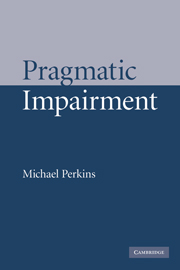Book contents
- Frontmatter
- Contents
- List of figures
- List of tables
- Acknowledgements
- Transcription conventions
- 1 Introduction
- 2 Pragmatic theory and pragmatic impairment
- 3 Pragmatics and modularity: components, dissociations and associations
- 4 Pragmatic ability and disability: an emergentist model
- 5 Cognition and pragmatics
- 6 Language and pragmatics
- 7 Sensorimotor systems and pragmatics
- 8 Compensatory adaptation
- 9 Conclusions
- Appendix
- References
- Index
7 - Sensorimotor systems and pragmatics
Published online by Cambridge University Press: 22 September 2009
- Frontmatter
- Contents
- List of figures
- List of tables
- Acknowledgements
- Transcription conventions
- 1 Introduction
- 2 Pragmatic theory and pragmatic impairment
- 3 Pragmatics and modularity: components, dissociations and associations
- 4 Pragmatic ability and disability: an emergentist model
- 5 Cognition and pragmatics
- 6 Language and pragmatics
- 7 Sensorimotor systems and pragmatics
- 8 Compensatory adaptation
- 9 Conclusions
- Appendix
- References
- Index
Summary
Introduction
Apart from obvious examples such as the use of gesture to compensate for linguistic output problems and the use of facial expression and tone of voice to interpret the attitudinal or emotional state of a speaker during comprehension, sensory input and motor output systems are rarely included in discussions of pragmatic ability and disability. However, once pragmatic functioning is seen as an emergent phenomenon it is clear that sensorimotor systems provide a range of communicative choices in the same way that cognitive and linguistic systems do; that restriction in choice as a result of impairment is pragmatically constraining and can have a knock-on effect both within the sensorimotor domain and in cognitive and linguistic domains; and that sensorimotor systems are as vulnerable as language and cognition to the effects of compensatory adaptation during interpersonal communication. The role of this chapter is therefore to round out and complete the emergentist model of pragmatics. However, because this is a relatively unexplored area, the chapter is of necessity considerably shorter than the preceding ones on cognition and language and aims to do no more than provide a programmatic outline with pointers for future research.
As outlined in Chapter 4, motor output systems govern the movements of the vocal tract, hands, arms, face, eyes and body, and sensory input includes auditory and visual perception.
- Type
- Chapter
- Information
- Pragmatic Impairment , pp. 139 - 145Publisher: Cambridge University PressPrint publication year: 2007



